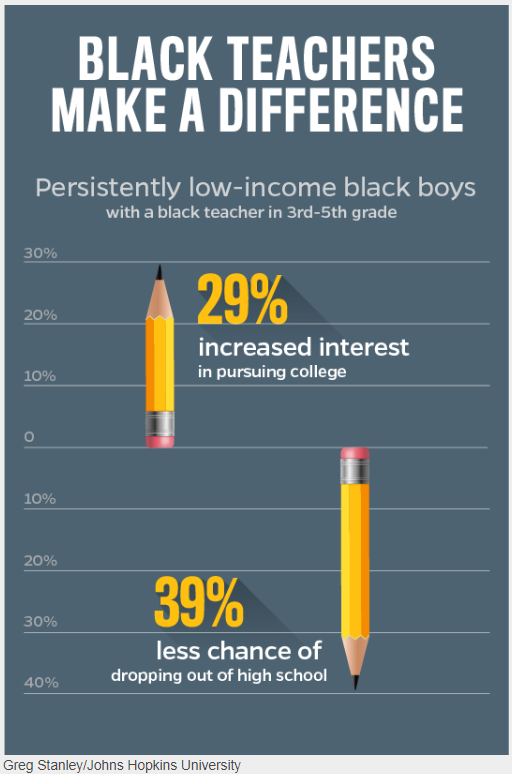
TEACHER REPRESENTATION MATTERS: WHAT THE RESEARCH SAYS
The following page is designed to inform you the importance of teacher representation within the classroom.
"The gap in achievement across racial and ethnic groups has been a focus of education research for decades, but the disproportionate suspension and expulsion of Black, Latino, and American Indian students has received less attention."
-Anne Gregory, Russell J. Skiba, Pedro A. Noguera (American Educational Research Association)
Substantial evidence indicates that students of color are disproportionately punished in schools nationally, and specifically in the District of Columbia [1]. More research has been conducted for Black students than for other minority groups, but numerous studies found that Latinx and Native American students are disproportionately being disciplined as well [2]. The more time a student misses class due to disciplinary actions, the less time that student receives academic instruction. Research suggests that “frequent suspensions appear to significantly increase the risk of academic underperformance” [2]. The disproportionate levels of punishment students of color receive could directly impact their levels of academic achievement, which is a trend currently seen within our nation's capital.
Language Barriers Hurt Student Achievement
Even though Latinx students make up approximately 20 percent of DCPS and 16 percent of public charter schools, only eight percent of DCPS teachers identify as Latinx (charter schools are not required to report this information) [8]. This becomes even more problematic because Latinx students make up approximately 77 percent of the nation's English language learners (ELL) [9]. There is no reliable information regarding how many DC public school and charter school teachers speak a second language, which puts an unfair burden on the teaching staff who does speak a second language [11]. This makes it difficult for school districts to retain diverse teachers. They may also explain lower assessment results from Latinx and ELL students in the District.
According to the DC Office of the State Superintendent of Education's Assessment Report, Latinx students have the third lowest proficiency scores on state standardized assessments [10].
- 32 percent of Latinx students show proficiency on the literacy assessment
- 28 percent of Latinx students showed proficiency on the math assessment
- 19 percent of ELL students showed proficiency on the literacy assessment
- 21 percent of ELL students showed proficiency on the math assessment
Students Benefit from Teachers of Color
"Minority students often perform better on standardized tests, have improved attendance, and are suspended less frequently (which may suggest either different degrees of behavior or different treatment, or both) when they have at least one same-race teacher."
-David Figlio (Dean for the School of Education and Social Policy at Northwestern University.)

Substantial research indicates that students of color do better in school when they have at least one teacher of color. Students of color perform better on standardized test, have higher rates of attendance, and are disciplined less frequently when they have at least one teacher of the same race [3]. Teachers of color are shown to boost the academic performance of students of color, showing improvements in reading and math test scores, improved graduation rates, and higher aspirations to attend college [4]. Assigning a Black male student to a Black teacher in the third, fourth, or fifth grades reduces high school dropout rates by 39%. Having at least one black teacher in these grades also increased the likelihood that "persistently low-income students of both sexes aspire to attend a four-year college" [2].
Gender Representation Benefits All
A teacher's gender does not have a significant impact on students in elementary grades, but it plays more of a role the older children become. A study analyzing 25,000 students from 1,000 schools found that when eighth graders had a female teacher, the boys fell behind girls by about three and a half months of instructional learning [12]. Studies have also shown that when female high school and college students have a female teacher in math and science courses, they participate more in class, get better grades, and are more likely to continue studies in that subject area in the future [13].
Diversity of Role Models
"Children are brought up in this country and they fear black men. Putting a black man in the front of a classroom does a lot to shift the narrative about how young children perceive black men in this country."
-William Hayes (Vice-Chair of The Fellowship)
The Brookings Institute (2016) highlighted that students of color “might benefit from seeing adults with a similar racial/ethnic background in a position of authority” [5]. The diversity within communities of color often is not portrayed in modern forms of media, and it is important to note that having teachers of color within school buildings can actively combat the stereotypes placed on students of color. The stigma linking academic success to being White can be challenged when teachers of color push students of color to achieve academic success [5]. Students should have access to a more diverse group of role models than the entertainers they watch or listen to.

MORE FAVORABLE PERCEPTIONS
"A black student with the same scores as a white student is still only half as likely to be assigned to a gifted program."
-Jason A. Grissom (Associate Professor of Public Policy at Vanderbilt University)
Research from Seth Gershenson, Cassandra Hart, Constance Lindsay, and Nicholas Papageorge (2017) suggests that Black primary-school students who were matched with a same-race teacher not only performed better on standardized test but their teachers had more favorable perceptions of them [2]. The Brookings Institute (2016) hypothesize that teachers of color might hold higher expectations for their students of color due to their own perceptions about their students’ “abilities, effort, and behavior” [5]. These findings indicate that inherent biases may influence the perceptions teachers have on students of color. When students and teachers share the same gender identity, teachers had more "favorable impressions" of their students [12]
Cultural Competency

Source: The Ed Trust: https://edtrust.org/resource/our-stories-our-struggles-our-strengths/
To assume that all teachers of color share the diverse experiences of their students of color is misguided. Research does suggest that having a more diverse teaching staff might create an environment that is “more culturally sensitive and less likely to subscribe to biased stereotypes about their students” [5]. A diverse teaching staff also influence more culturally relevant curricula where teachers are more likely to adapt lesson plans to the perspectives of their students [7]. Findings from the Brookings Institute (2016) says “students assigned to demographically similar teachers say their teachers notice if they don’t understand a topic and explain it another way. Also, difficult material is explained clearly and teachers take the time to provide feedback on students’ written work so they can understand how to do better in the future” [5]. Not only do students of color benefit from having teachers of color, but White students also “report having positive perceptions of their teachers of color, including feeling cared for and academically challenged” [4].
Limitations in Research
A large body of evidence in research shows disparities that exist between Black and White communities nationally, but there is a limited amount of work highlighting the inequalities that exist in other minority subsets [6]. The positive impact of having teachers of color within the classroom has been documented for students across most demographics, but limited information exists showing the impact specifically of Latinx teachers or teachers from indigenous communities. This is problematic because Latinx populations are the largest minority demographic nationally and they are the least representative group of teachers within school buildings nationally and locally.
Limited information is available locally about transgender and gender-nonconforming students and teachers.
Sources:
- Office of the State Superintendent of Education. (2019). State of Discipline: 2017-18 School Year. [online] Available at: https://osse.dc.gov/sites/default/files/dc/sites/osse/page_content/attachments/2017-18%20School%20Year%20Discipline%20Report.pdf
- Gershenson, S., Hart, C., Lindsay, C., & Papageorge, N. (2019). The Long-Run Impacts of Same-Race Teachers. Retrieved from http://ftp.iza.org/dp10630.pdf
- Figlio, D. (2019). The importance of a diverse teaching force. Retrieved from https://www.brookings.edu/research/the-importance-of-a-diverse-teaching-force/
- Teachers of Color: In High Demand and Short Supply. (2019). Retrieved from https://learningpolicyinstitute.org/press-release/teachers-color-high-demand-and-short-supply
- Kisida, A. (2016). The many ways teacher diversity may benefit students. Retrieved from https://www.brookings.edu/blog/brown-center-chalkboard/2016/08/19/the-many-ways-teacher-diversity-may-benefit-students/
- Gregory, A., Skiba, R., & Noguera, P. (2010). The Achievement Gap and the Discipline Gap. Educational Researcher, 39(1), 59-68. doi: 10.3102/0013189x09357621
- Thomas S. Dee & Emily K. Penner, 2017. "The Causal Effects of Cultural Relevance," American Educational Research Journal, vol 54(1), pages 127-166.
- DCPS Fast Facts 2017-18. (2018). Retrieved from https://dcps.dc.gov/sites/default/files/dc/sites/dcps/publication/attachments/DCPS-Fast-Facts-2019-20.pdf.
- Shapiro, S., & Partelow, L. (2018). How To Fix the Large and Growing Latinx Teacher-Student Gap. Retrieved from https://cdn.americanprogress.org/content/uploads/2018/02/20061952/020118_LatinxTeacherStudentGap-brief-2.pdf
- OSSE NGA Web Report. (2018). Retrieved from http://results.osse.dc.gov/state/DC
- Griffin, A. (2018). Our Stories, Our Struggles, Our Strengths - The Education Trust. Retrieved from https://edtrust.org/resource/our-stories-our-struggles-our-strengths/
- Cain Miller, C. (2018). Does Teacher Diversity Matter in Student Learning?. Retrieved from https://www.nytimes.com/2018/09/10/upshot/teacher-diversity-effect-students-learning.html
- Breda, T., Grenet, J., Monnet, M., & Van Effenterre, C. (2018). Can female role models reduce the gender gap in science? Evidence from classroom interventions in French high schools. Retrieved from https://halshs.archives-ouvertes.fr/halshs-01713068/document
